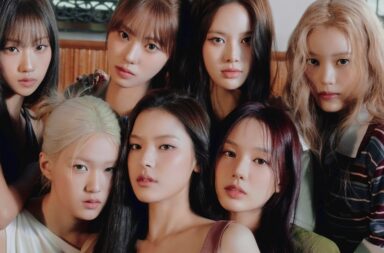
Nafla first burst onto the Korean hip hop scene in 2015 with his This and That mixtape which would end up winning both the “Best Mixtape Performance of the Year” and “Best Mixtape of the Year” in the 2016 HipHople Mixtape Awards. Following this Nafla would co-found the American-Korean hip hop label MKIT RAIN in 2016, release his debut album Angels in 2017 and win SMTM 777 in 2018. During 2019, Nafla released three singles: “saturday,” “merlot,” and “love me.” These singles would become the foundation of Nafla’s newest album; u n u part. 1. A record which indicates a substantial shift in sonic scapes for Nafla’s sound.
This shift is especially felt when contrasted by his most sizeable contribution of his joint-album with Loopy entitled LooFla. The contrasting elements between these two records, from the trap flavoured loopings of LooFla to the R&B infused landscapes of part. 1 play out as the two sides of Nafla’s musical personality. Part. 1 spins its lyrical lines of loneliness and heartbreak into a record that sits comfortably with the growing jazz hip-hop scene in LA, where MKIT RAIN is based.
The “part. 1” titling naturally indicates that this record will be a two-part affair, in a similar fashion to that of Zico‘s Thinking which was broken into two EP’s. Again we see Nafla playing with dualities. One half of the record showing Nafla’s quieter side that could indicate its second half would be the place for Nafla’s boom-bap tethered sound to perhaps return?

Interestingly, of the eight tracks on part. 1, half have been heard before the official release: the aforementioned three pre-singles and “been,” a track dating back to 2016. Therefore, there are 4 known tracks and 4 unknown tracks on part 1. Whether this was by design or just by coincidence, it would seem Nafla has been creating in two’s.
Duality is a growing trend, especially in the hip-hop sphere. With various concepts of dualities being established throughout the past decade. An example is Kendrick Lamar‘s Damn which had two different records, one which played in its normal tracklisting, while the other album played in reverse. There is also Crush‘s From Midnight To Sunrise, being taken quite unironically from Midnight to Sunrise, shaping the mood and flow within the contrasting timepieces.
Going into 2020, there are two major trains of thought surrounding the album formats. One school of thought believes that albums are still significantly important to telling your story as an artist and require various layers of construction. This is supported by the idea that most critically acclaimed albums are complex in their construction.
The other train of thought believes that the album format is insignificant, to be done away with by the emerging importance of playlists within streaming sites. As such, there are modern albums with over 20 tracks so that listeners have the maximum amount of content to create their playlists. This train of thought is supported by the decrease in physical album sales and listenership of albums contrasted by the increased use of streaming services and single track listenership.
Nafla’s approach seems an answer to both trains of thought, resulting in a well-constructed album in touch with the times. An album split into two, allowing for new concepts of duality to be placed within the layering of the album, while also giving listeners a constant stream of music and MV’s all encapsulated under one release.
The first MV released was “merlot,” a jazz driven piece wrung out to dry by lyrics of heartbrokenness. Its accompanying MV similarly plays in a loop of dead relationships and red imagery in honour of the namesake of the track, merlot, a type of red wine. Meanwhile, Nafla’s vocals are wrapped around the instrumental with stunning clarity. This leads to the influences of the MV to dazzle instead of coming off as a cheap imitation. The closed casket scene seems in ode of Mac Miller‘s “Self-Care” MV rather than a tribute to the Quentin Tarantino‘s “Kill Bill” scene which popularized the modern trapped in a casket motif.
Mac Miller’s Swimming album would, therefore, seem an influence on the record’s ethos. Similar to Nafla, Swimming was a continued departure from Mac’s rap heavy cadences to a more dexterous vocal delivery. Both records also both live under the umbrella of introspection, dealing primarily with emotion especially loneliness brought on by fame. This perceived inspiration could once again be by design or mere coincidence. As interestingly, Mac Miller’s Swimming record was also created in two, with Circles having been posthumously announced as the companion album to Swimming one day after part.1 released.

Another album which likely shares the same structure as u n u as a whole is Owen‘s Smile record. A quick look at Owen’s record shows that it is also divided into two, with 8 tracks on side 1 and 8 tracks on side 2. The icing on the cake of their stylistic similarities is that both Nafla’s part.1 and Owen’s Smile have all their tracks written in lower case. If the second half of u n u is also 8 tracks long then Smile and u n u will have the same structural DNA while also both being fathered by MKIT RAIN artists.
Owen coincidently features on the record in the shape of “apple pie”, a track that weaves and bobs similar to something out of Nujabes’ Samurai Champloo. Owen’s animated cadence work feverishly well on this track, while Nafla’s vocal serves as the anchor of the track stopping it from spiralling out of control and away from the theme of the record. The groove of “apple pie” is second only to that of “gucci girl”, which was the second MV released for part.1.
“Gucci girl” shimmers and shakes the way a Samuel Seo song would in its colourful swagger that is caught in a guitar loop. “Gucci girl”‘s accompanying MV contrasts in its mood where the storyline of the MV is trapped in an American prom night theme. While the majority of the MV has Nafla roaming around hopelessly, caught in unexpected moments, there is also a lovely colour palette being used in this MV, with blue tones being juxtaposed by occasional piercing orange lights that both cut through the mist and the loneliness held in the MV.
It must be said that Part. 1‘s most powerful moment comes during its close. The closing moment in question is “good morning” a track stripped bare with only one dominant instrument in its composition and Nafla’s most vulnerable vocal performance on the album.”Good morning” also weaves a beautiful conceptual dance with the albums opener “ice coffee”. Where “good morning”‘s lyrical performance opens with the imagery of tea, “ice coffee” of course plays with the imagery of its namesake, coffee. Showing that while part. 1 is a prelude to u n u, Part. 1 is still a small completed world of its own, with a plausible beginning that is tied to its end.
AppleMusic, AOTY, The Guardian, Pitchfork, Landr, BBC, Spotify, Genius YouTube (1)(2)(3), Images via MKRIT RAIN


